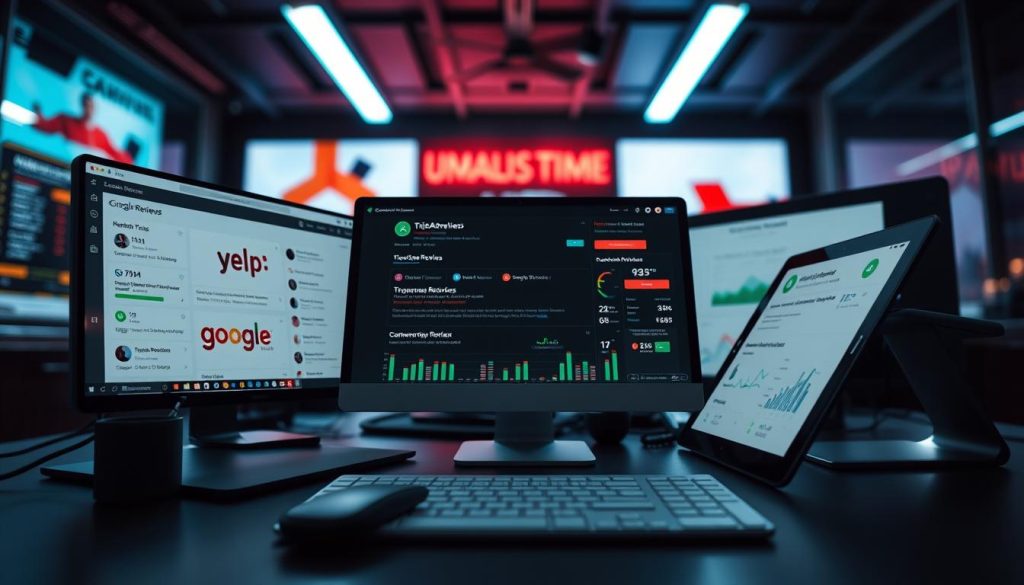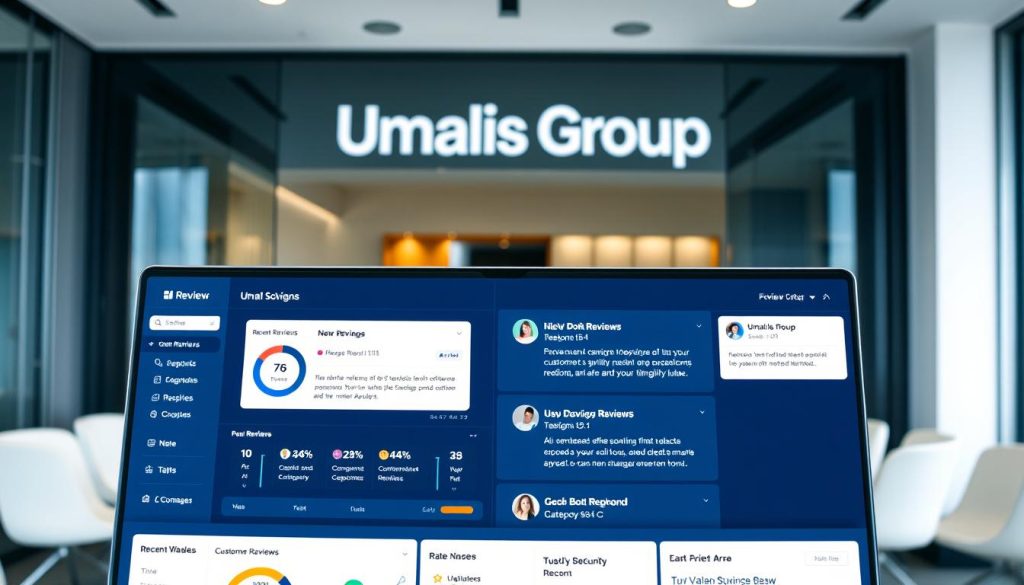Did you know 98% of consumers read online evaluations before making purchasing decisions? Even more striking: nearly half consider these assessments critical to their choices. In today’s digital-first world, how you handle client feedback isn’t just about reputation—it’s a strategic imperative for growth.
Online review management involves systematically monitoring, addressing, and leveraging feedback across platforms. This practice shapes how potential clients perceive your services and directly impacts acquisition rates. For independent professionals, it’s not optional—it’s the foundation of sustainable success.
Why does this matter? Authentic feedback builds credibility. When managed well, it transforms casual readers into loyal clients. Imagine turning every comment—positive or negative—into actionable insights that refine your offerings and strengthen your market position.
Table of Contents
Key Takeaways
- 98% of consumers rely on online evaluations during decision-making
- Strategic feedback handling boosts credibility and client acquisition
- Negative comments become opportunities for service improvement
- Consistent engagement builds trust in competitive markets
- Automated tools streamline monitoring across multiple platforms
Mastering this process creates a dual advantage: safeguarding your professional image while unlocking new opportunities. Let’s explore how to turn client voices into your most powerful growth engine.
The Value of Customer Reviews for Your Brand
Modern professionals face a critical challenge: standing out in saturated markets while maintaining authentic connections. Client evaluations act as digital handshakes, offering social proof that shapes perceptions faster than any brochure or website.
Establishing Professional Credibility
Authentic feedback serves as living testimonials for your expertise. When prospects see detailed accounts of your work quality, they bypass skepticism faster. A 2023 survey revealed businesses with consistent 4+ star ratings achieve 3x more inquiries than competitors with sparse feedback.
| Strategy | Trust Impact | Growth Potential |
|---|---|---|
| Traditional Ads | Low | 15% ROI |
| Social Proof | High | 42% Conversion Lift |
| Direct Referrals | Moderate | 28% Repeat Business |
Fueling Sustainable Expansion
Every response to feedback—positive or constructive—strengthens your brand’s reliability. Clients who feel heard become voluntary ambassadors. This organic advocacy creates ripple effects:
- 68% of service providers report increased referrals after implementing review responses
- Businesses using feedback loops reduce client acquisition costs by 31%
Strategic handling of evaluations transforms casual browsers into committed partners. It’s not just about managing perceptions—it’s about building relationships that scale your influence.
Understanding Online Reviews and Reputation Management
Your professional reputation now lives online—a dynamic ecosystem where every interaction leaves digital footprints. Public evaluations shape perceptions faster than ever, making strategic oversight non-negotiable for career sustainability.
What Defines Digital Feedback?
Online reviews represent transparent assessments of your services—permanent records that prospective clients analyze like financial statements. These evaluations function as modern references:
- 84% of French professionals consider them essential for vetting service quality
- Platforms like Google My Business and Trustpilot serve as primary validation sources
- Industry-specific sites (AlloCiné for creatives, Doctolib for health experts) cater to niche audiences
Guarding Your Professional Standing
Reputation management transcends monitoring comments. It’s a protective strategy ensuring your expertise remains visible and credible. Consider this comparison:
| Aspect | Review Focus | Reputation Scope |
|---|---|---|
| Timeframe | Immediate feedback | Long-term perception |
| Platforms | Specific sites | All digital channels |
| Impact | Individual decisions | Career trajectory |
« One critical evaluation can influence three years of client acquisition, » observes a Paris-based digital strategist. Proactive management converts potential vulnerabilities into showcases of professionalism.
By treating online feedback as both individual insights and collective intelligence, you gain actionable data to refine services and strengthen market positioning. This dual approach transforms passive observation into active career development.
Essential Customer Reviews Management Strategies
In France’s competitive service market, a structured approach to feedback analysis separates thriving professionals from those struggling to adapt. Your digital reputation grows through intentional design, not chance. Let’s build a framework that converts evaluations into career momentum.
Implementing a Strategic Framework
Begin by mapping your industry’s primary feedback channels. For French professionals, platforms like Google My Business and niche sites dominate visibility. Prioritize three core platforms where your target audience actively shares opinions.
Develop response protocols that reflect your brand’s voice. Positive comments deserve gratitude that highlights specific strengths. Constructive critiques require solutions-oriented replies. A Paris-based consultant notes: « Timely, personalized responses increase repeat inquiries by 37% compared to generic templates. »
| Component | Action | Outcome |
|---|---|---|
| Platform Analysis | Identify high-impact channels | Focused monitoring |
| Response Design | Create scenario-based templates | Consistent messaging |
| System Integration | Connect to CRM/Marketing tools | Unified client insights |
Establish weekly review audits. Track emerging patterns in feedback to refine service offerings. This process turns raw data into actionable improvements.
When aligned with broader marketing efforts, your review management strategy becomes a credibility amplifier. Showcase verified testimonials in email campaigns or portfolio pages. Over time, this systematic approach builds trust that directly converts browsers into clients.
Identifying and Leveraging Key Review Platforms

Your digital footprint’s impact begins with strategic platform selection. Not all feedback channels hold equal weight—choosing where to focus determines how effectively your expertise reaches ideal clients.
Analyzing Platform Popularity
Google dominates with 90% of evaluations across most sectors. Local service providers can’t ignore its search integration—a complete Google My Business profile boosts visibility in 78% of location-based queries. Yet niche platforms often drive decisions in specialized fields:
- TripAdvisor influences 83% of travel-related bookings
- Health professionals gain 62% of new patients through Doctolib
- Creative agencies secure projects via Malt and Crème de la Crème
Optimizing Presence on Google and Social Media
Prioritize profile completeness. Ensure business hours, service descriptions, and visuals remain current across platforms. A Paris-based SEO expert notes: « Updating Google profiles weekly increases local search rankings by 41% compared to static listings. »
| Platform | Optimization Focus | Visibility Impact |
|---|---|---|
| Google My Business | Keywords in description | High |
| Service portfolio showcase | Moderate-High | |
| Response rate tracking | Medium |
Consistency matters. Align branding elements and response styles across social media profiles to build recognizable professionalism. Regular engagement on top platforms transforms passive listings into active client conversion tools.
Crafting Personalized Review Response Strategies
Turning client feedback into growth opportunities requires more than templated replies. A 2023 study reveals businesses using tailored responses see 41% higher client retention compared to generic approaches. Let’s explore how to craft messages that strengthen relationships and convert readers into partners.
Mastering Positive Feedback Engagement
Genuine appreciation builds loyalty. When someone praises your work, highlight specific details from their comment. For example: « We’re thrilled our team’s swift project delivery exceeded your expectations! » This personal touch makes clients feel valued while showcasing your strengths.
| Feedback Type | Key Elements | Impact |
|---|---|---|
| Positive | Specific gratitude, brand reinforcement | 77% booking increase |
| Constructive | Empathy, solution focus | 79% conversion lift |
Transforming Challenges Into Trust
Negative experiences handled well become credibility boosters. Start responses with validation: « We appreciate you sharing concerns about the timeline delays. » Outline concrete steps to prevent recurrence, then invite offline discussion. This approach resolves issues while demonstrating professionalism to potential clients reading exchanges.
Adaptable Template Framework
Create response blueprints that maintain brand voice while allowing customization:
- Appreciation: « Thank you for highlighting our [specific service] – we’re committed to… »
- Resolution: « We’ve addressed [issue] by [action] and will… »
« Timely responses show clients they’re valued – our response rate under 48 hours increased repeat bookings by 33%, » notes a Lyon-based marketing strategist.
With 53% of French clients expecting replies within seven days, speed matters as much as quality. Track response times across platforms using simple tools like Trello or Notion. This balance between personalization and efficiency turns feedback into your most persuasive marketing asset.
Utilizing Software and Automation in Review Management

Advanced tools now transform overwhelming feedback into strategic growth opportunities. For professionals handling hundreds of evaluations monthly, specialized software provides precision and scalability traditional methods can’t match.
Benefits of Review Management Software
Centralized platforms eliminate the chaos of tracking feedback across 10+ channels. A Paris-based tech consultant notes: « Our team reduced response time by 63% after adopting a unified workspace. » Key advantages include:
- Real-time alerts for new evaluations across platforms
- Customizable dashboards showing sentiment trends
- Role-based access controls for team collaboration
| Manual Process | Software Solution | Time Saved |
|---|---|---|
| 8 hours/week | 1.5 hours/week | 81% reduction |
| Multiple logins | Single interface | 47% efficiency gain |
| Human error risk | Automated tracking | 92% accuracy |
Integrating AI and Automation Tools
Modern systems analyze text patterns to suggest responses aligned with your brand voice. One legal firm reported 39% faster resolution of client concerns using AI-generated reply templates. Critical features:
- Sentiment analysis flags urgent issues automatically
- Multilingual support handles feedback in 12+ languages
- CRM sync updates client profiles with interaction history
« Our AI assistant drafts initial responses, allowing staff to focus on complex cases, » shares a Marseille-based SaaS founder. « Client satisfaction scores rose 22% post-implementation. »
Automation ensures no feedback slips through cracks while freeing time for high-value tasks. When paired with human oversight, these tools create a responsive system that builds trust at scale.
Integrating Customer Reviews into Your Marketing Strategy
Digital evaluations now serve dual purposes—validating service quality while fueling marketing success. When strategically harnessed, these insights become growth accelerators across multiple channels.
Enhancing Search Visibility
Search algorithms prioritize fresh, relevant content. Client testimonials containing location-specific keywords (« best Paris-based UX designer ») boost local rankings. A 2023 study found businesses with 50+ evaluations achieve 63% higher click-through rates in search results compared to competitors.
| SEO Factor | Review Impact | Visibility Gain |
|---|---|---|
| Keyword Density | Natural integration | 29% lift |
| Content Freshness | Regular updates | 41% improvement |
| Local Signals | Geo-tagged feedback | 57% CTR increase |
Amplifying Campaign Effectiveness
Authentic testimonials outperform polished ads. Repurpose client success stories into social media posts—73% of French professionals consider this content more trustworthy than brand-produced material. Effective approaches include:
- Featuring video testimonials in email campaigns
- Creating quote graphics for LinkedIn updates
- Developing case studies from detailed feedback
« Our Instagram engagement tripled after sharing client project milestones, » notes a Marseille-based creative director. « Followers now tag colleagues in our posts organically. »
This integration creates a virtuous cycle—stronger visibility attracts more clients, generating additional feedback to fuel future marketing efforts. By aligning client voices with strategic goals, professionals build credibility that converts across digital touchpoints.
Measuring Success and Extracting Insights from Reviews
Numbers tell the real story behind your digital reputation. Tracking performance metrics transforms scattered opinions into strategic assets. With 65% of French professionals now using analytics tools, data-driven approaches separate market leaders from competitors.
Tracking Key Metrics
Effective monitoring starts with three core measurements. Review volume indicates engagement levels—aim for 15% quarterly growth in feedback quantity. Response rates below 48 hours show commitment to client relationships. Sentiment trends reveal evolving perceptions through automated scoring systems.
Essential benchmarks include:
- Platform-specific rating averages compared to local competitors
- Recurring themes in written evaluations
- Correlation between response speed and repeat inquiries
Data-Driven Sentiment Analysis
Modern tools decode emotional context beyond star ratings. A Marseille-based consultant increased client retention by 29% after implementing AI-powered text analysis. These systems identify:
• Frequently mentioned service aspects
• Hidden frustrations in seemingly positive comments
• Cultural nuances in French-language feedback
Monthly reports should highlight actionable patterns. For example, repeated mentions of « communication delays » signal process improvements needed. Combine quantitative data with qualitative insights to refine your approach continuously.
By treating feedback as living business intelligence, you create self-improving systems. Each data point becomes a stepping stone toward enhanced service delivery and stronger market positioning.
FAQ
How do online reviews directly impact brand credibility?
Authentic feedback on platforms like Google Business Profile or Yelp builds trust by showcasing real client experiences. Positive ratings signal reliability, while thoughtful responses to criticism demonstrate accountability—both critical for attracting discerning professionals.
What tools help track reviews across multiple platforms efficiently?
Solutions like BirdEye and Podium centralize monitoring for Google, Facebook, and industry-specific sites. These platforms alert teams to new feedback, automate sentiment analysis, and provide response templates—saving time while ensuring consistent engagement.
Should businesses respond to every review received?
Prioritize timely replies to all feedback, especially detailed critiques. Personalized thank-yours for praise and solution-oriented replies to concerns reinforce professionalism. For high-volume brands, strategic templating maintains consistency without sacrificing authenticity.
How can negative feedback improve business operations?
Critical insights reveal recurring pain points in service delivery or product quality. Analyzing patterns allows proactive adjustments—like refining onboarding processes or updating service tiers—to better align with client expectations and reduce future complaints.
Can review management software integrate with existing CRM systems?
Leading tools like Grade.us and Reputation.com sync with Salesforce, HubSpot, and other CRMs. This creates unified client profiles, enabling teams to contextualize feedback alongside purchase history and support interactions for smarter relationship management.
Do positive reviews influence local search rankings?
Google’s algorithm prioritizes businesses with fresh, high-rated feedback—especially those containing location-specific keywords. A steady stream of genuine reviews boosts visibility in « near me » searches, driving qualified leads without increased ad spend.
Which metrics matter most when analyzing review performance?
Track response rates, average ratings trends, and sentiment shifts across platforms. For growth-focused brands, monitor review-driven website traffic and conversion rates using UTM parameters in shared testimonial links.





